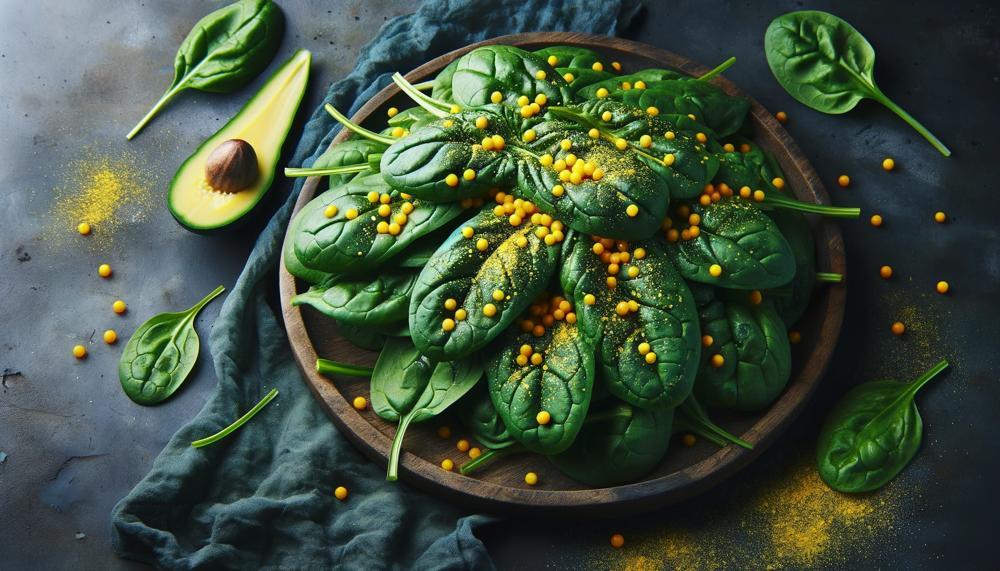When it comes to consuming spinach with yellow spots, it’s important to consider the quality and safety of the spinach. If the leaves have yellow spots, it may be a sign of spoilage or disease.
According to the University of Kentucky College of Agriculture, Food, and Environment, you should avoid spinach with brown, black, or yellow discolorations as these could indicate the presence of a disease.
Additionally, if the spinach smells sour or musty, it is likely spoiled and should not be consumed. Slimy or mushy texture is another indication that the spinach has gone bad.
However, wilted spinach can still be eaten and can be revived by soaking it in a cold-water bath. It’s always better to err on the side of caution and discard spinach with yellow spots to ensure your health and safety.
Contents
Key Takeaways:
- Avoid consuming spinach with yellow spots, as they could indicate spoilage or disease presence.
- Spinach with brown, black, or yellow discolorations should be avoided.
- Do not consume spinach that smells sour or musty.
- Wilted spinach can still be eaten but discard if it becomes slimy or mushy.
- Revive wilted spinach by soaking it in a cold-water bath.
Can you eat spinach with yellow spots?
Spinach leaves with a few spots can still be eaten. However, you should throw away spinach if the leaves are yellow, discolored, wilted, or have spots of drastically darkened color. Slimy spinach leaves are also a sign of rot.
Spinach can be contaminated with bacteria such as E. coli. Bacterial spots are different in appearance from fungal diseases, but they are just as bad for you to eat. White spots indicate bacteria, fungus or rot, so if your spinach has them, you should throw it away.
Spinach leaves can turn yellow for a number of reasons, including:
- Overwatering: If the roots are drowning, the leaves will start to yellow.
- Downy mildew: Irregular yellow spots on the upper leaf surface.
- White rust: A serious problem on spinach, caused by the water mold Albugo occidentalis.
How to Tell if Spinach Is Bad?

When it comes to determining if spinach is bad, there are several signs to look out for. By recognizing these signs, you can ensure that you are consuming fresh and safe spinach.
Signs of Spoiled Spinach:
- Slimy Texture: If the spinach leaves feel slimy or mushy to the touch, it is a clear indication that the spinach has gone bad. Wilted spinach is still edible, but once it becomes slimy, it should be discarded.
- Spotty or Discolored Leaves: Avoid spinach with brown, black, or yellow spots, as these can be signs of spoilage or disease. Opt for spinach with vibrant green leaves.
- Off-Smell: If the spinach emits a sour or musty odor, it is likely spoiled. Trust your sense of smell and discard any spinach that doesn’t smell fresh.
- Mold Growth: Visible mold on the spinach is a clear indication that it is no longer safe to consume. Mold can be harmful to your health, so it’s important to discard any spinach with mold growth.
By paying attention to these signs, you can determine if your spinach is still good to eat or if it needs to be discarded. Remember to prioritize your health and safety when it comes to consuming perishable foods like spinach.
Refer to the table below for a visual summary of the signs of spoiled spinach:
| Signs of Spoiled Spinach | What to Do |
|---|---|
| Slime or mushy texture | Discard the spinach |
| Spotty or discolored leaves | Avoid consuming |
| Off-smell | Do not consume |
| Mold growth | Throw away the spinach |
How to Keep Spinach Fresh?
To keep spinach fresh for as long as possible, proper storage is key. When buying spinach, look for leaves that are vibrant green, firm, and crisp. Avoid spinach with discolored or watery stems.
Once you have purchased spinach, it’s important to store it correctly. Remove any wilted or rotten leaves before storing, as they can cause the rest of the spinach to spoil more quickly. Place the spinach in a container lined with paper towels to absorb excess moisture. Make sure the container is tightly sealed to prevent air from entering.
It’s also important not to wash spinach before storing, as excess moisture can promote spoiling.
| Storage Tips for Keeping Spinach Fresh: | |
|---|---|
| 1. Select fresh and vibrant green spinach leaves | |
| 2. Remove any wilted or rotten leaves | |
| 3. Place spinach in a container lined with paper towels | |
| 4. Seal the container tightly to prevent air exposure | |
| 5. Avoid washing spinach before storing |
By following these storage tips, you can extend the shelf life of your spinach and keep it fresh for as long as possible.
How to Freeze Spinach?
Freezing spinach is a great way to extend its shelf life. To freeze spinach, start by blanching it in boiling water for about two minutes. Then, immediately transfer the blanched spinach to a bowl of cold water to stop the cooking process. Once cooled, portion the spinach into serving sizes or place portions in an ice cube tray.
Place the spinach in a freezer bag, ensuring to remove as much air as possible to avoid excess moisture. Label the bag with the date and store it in the freezer. Frozen spinach can last between nine and fourteen months if stored properly.
Blanching helps retain the taste and color of the spinach, although it may cause some loss of nutrients.
Freezing spinach is a convenient method to have a supply of spinach on hand for future use.
Conclusion
In conclusion, it is not recommended to eat spinach with yellow spots. The presence of yellow spots on spinach leaves could indicate spoilage or the presence of disease.
It’s important to pay attention to signs of spoilage such as a slimy texture, off-smell, and mold growth. Wilted spinach can still be consumed, but once it becomes slimy or mushy, it should be discarded.
By properly storing spinach and practicing good food safety habits, you can ensure the freshness and safety of your leafy greens.
If in doubt, it’s best to err on the side of caution and avoid consuming spinach with yellow spots to protect your health.




